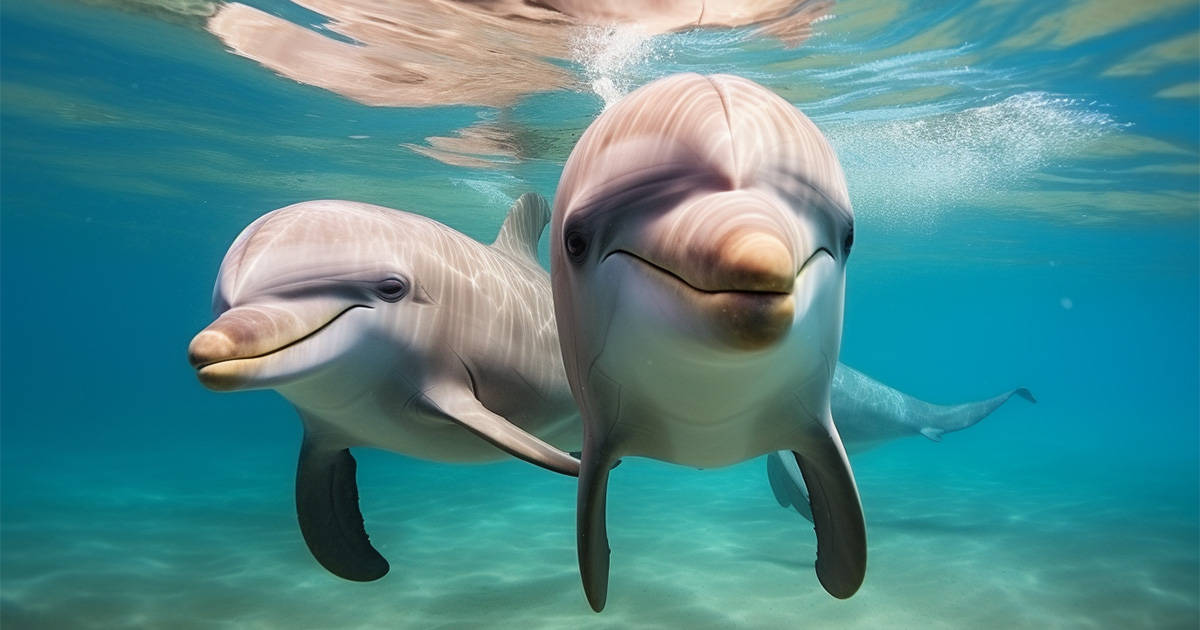Dolphins living off a remote, wild coast began to play with people more than 40 years ago in Shark Bay, Western Australia. The human-dolphin cultural exchange continues to grow today, bringing economic prosperity to the small town whose mining community had gone dry from isolated economic stagnation.
Countless dolphins have been exposed to humans in myriad ways over the decades, and the two species have gotten along famously while generating a lot of money. It’s not just ocean tourists who spend their money to interact with tame pods of dolphins, though. The friendly cetaceans are also the darlings of scientists.
Researchers have proved that the dolphins know a good bay when they see one. Thanks in great part to its dolphins, Shark Bay is now a world heritage site. The government-managed conservation area has terrestrial and marine parks, two towns, fine hotels, docks and an airstrip. The site encompasses the largest sea grass bank anywhere, and the highest sea grass diversity in the world; it is home to more than 10 percent of the planet’s dugongs (manatees), and provides crucial waters for whale and tiger sharks and humpback and right whales.
But the star attraction has always been the dolphins. The opportunity to hang out with these highly cognizant beings has turned into a kind of bottlenose dolphin university for scientists. The dolphins have illuminated intriguing social behaviors, some that we ourselves exhibit. Like with humans, the dolphins’ lives have not been all fun and games.
Delfinovela
Since at least the 1960s, at a sandy island point in Shark Bay known as Monkey Mia, a camp of adventuresome travelers has been fascinated by dolphins, which would swim right up to people. Meanwhile, busted booms of mining guano and cutting sandalwood, along with a “pearl rush” and plenty of overfishing had depleted resources and left people without work. So the cottage industry forming around sustainable human-dolphin interactions was beginning to look pretty promising.
After a couple decades, people also began to realize that a large group of dolphins willing to let the researchers do their thing was an important educational opportunity.
Today, Shark Bay is considered one of the most important world centers for dolphin research. Investigators began by getting to know some of the regular players hanging out with humans, and followed their activities. Currently, hundreds of dolphins a year are cataloged and a massive database of long-term records collected by an international team is managed by Georgetown University in Washington D.C.
So what have we learned about these Australian people of the sea?
Several of the original scientists who studied Shark Bay dolphins compare their lives to soap operas. Like many indigenous tribes, the sea creatures form very sophisticated, long-lasting alliances of large groups of males that raid and “herd” females from other groups. Females frequently escape by bolting away, but not always.
Also like human tribes, females who build alliances with other females have better success with their offspring. By using protective sponges on their beaks for hunting, much as we use gloves for work, dolphins have proven themselves to be tool users. Many Shark Bay dolphins are gay and bisexual. Males spend more time trying to figure out who their friends are than they do squabbling. There is very little aggression between females, or it is very subtle.
Still wanna be a dolphin?
Park rangers now supervise and control the dolphin-human interaction at the beach, and boats are kept out, in turn allowing the camp to blossom into an eco-resort. The nearby town is booming with associated services, and sustainable guidelines are employed by operators and hotels to protect against contaminating themselves out of business. The government of Australia proudly touts the human-friendly dolphins of Shark Bay as one of the nation’s greatest tourist attractions. In recent years, the wild dolphins have shown up almost every day.
The human-dolphin cultural exchange of Shark Bay has not just become an awesome and sustainable moneymaker, it has changed the world’s perception of animal intelligence and conservation. If something had stopped that amazing interspecies interaction, like say ocean drilling or overfishing, we would know a lot less about dolphins. And we’d understand less about ourselves.

